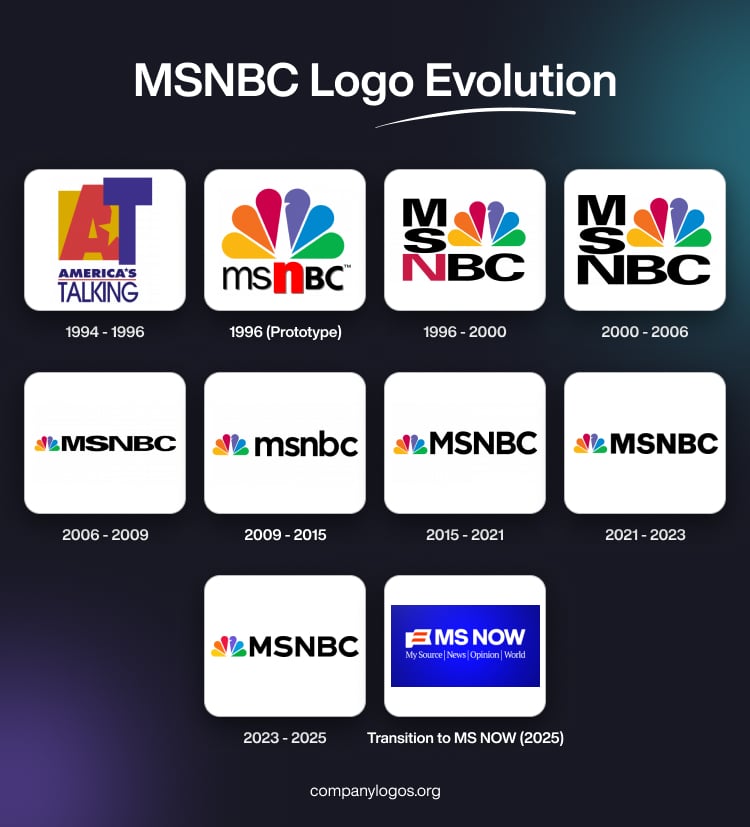
MSNBC is an American television channel known for broadcasting news programmes with a liberal perspective. Founded in 1996 and owned by NBCUniversal, the network has rebranded itself as MS NOW (My Source for News, Opinion and the World) in 2025.
The iconic MSNBC logo has undergone a remarkable transformation since the cable news network’s launch in 1996. From its original square design featuring the Microsoft-NBC partnership to the 2025 rebrand as “MS NOW”, the logo’s evolution tells the story of a network constantly adapting to changing media landscapes and corporate ownership structures. The article delves into the various logo changes undertaken by the MSNBC network, among other details.
The Genesis of the MSNBC Logo (1994 – 1996)
The precursor to MSNBC was the television channel America’s Talking. Its logo featured a big-sized letter “A” in red where its right leg was cut out in the shape of a star. In the foreground to the right was the letter “T” in blue. Both letters were set up against a yellow square. Beneath the emblem were written the words “AMERICA’S” and “TALKING” in blue using Futura Extra Bold and a modified version of ITC Avant Garde, respectively. A thin red horizontal line separated the two words.
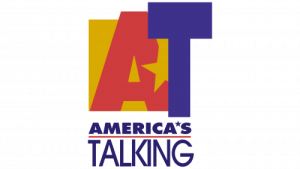
(1996) (Prototype)
In 1996, MSNBC replaced America’s Talking and got the name “MS” from Microsoft and “NBC” from NBC. The prototype logo during the period contained a peacock tail that was part of the NBC logo in 1986. Designed by Steff Geissbuhler of Chermayeff & Geismar, the tail had six coloured feathers, namely, yellow, orange, red, purple, blue, and green.
At the centre of the feathers appeared the white silhouette resembling the neck and head of the peacock. Beneath the emblem was written the brand name “msnBC”, where “msn” was written using a Franklin Gothic typeface and “BC” using NBC Futura. Among the letters, “msBC” was depicted in black with grey shadows, while the slightly enlarged “n” was shown in red. This prototype was used for promotions to launch the channel.
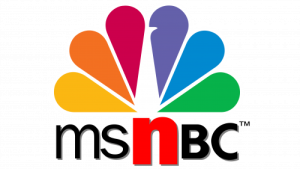
(1996 – 2000)
When MSNBC debuted on July 15, 1996, it represented an ambitious joint venture between Microsoft and NBC. The original logo reflected this partnership with a distinctive square-like design that featured “MSN” stacked vertically above “BC”, which was positioned alongside the iconic NBC peacock emblem.
The design utilised an Extended Extra Black sans serif typeface that was similar to the CNBC logo. The network experimented with variations during this period, including changing the letter “N” to red.
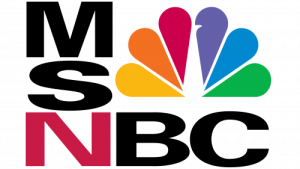
(2000 – 2006)
In the 2000 logo variation, the letter “N” was switched to black without changing any other element.
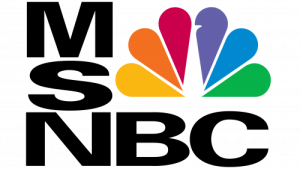
(2006 – 2009)
Around 2006, MSNBC made a design shift by adopting a horizontal layout that placed all five letters in a row beside the iconic peacock emblem. This change brought the logo closer in resemblance to CNBC’s established design and created a more streamlined appearance for on-screen use. The horizontal format would become the standard template for all subsequent MSNBC logo iterations.

(2009 – 2015)
In 2009, MSNBC introduced perhaps its most dramatic logo transformation. It switched the brand name from uppercase to lowercase letters and adopted the sans-serif Gotham Bold typeface. The lowercase letters featured gentler curves that were more closely aligned with modern design trends.
Also, the geometric lines of the lowercase letters created better harmony with the NBC peacock’s curved elements. They established visual coherence that had been lacking in previous iterations.

(2015 – 2021)
By 2015, MSNBC had returned to an uppercase design while maintaining the horizontal layout established in 2006. This iteration featured more refined spacing and bolder typography compared to earlier versions. It reflected advances in digital design capabilities and on-screen clarity requirements for high-definition broadcasting.

(2021 – 2023)
On March 29, 2021, MSNBC unveiled its logo update as part of a broader network redesign. The new logo maintained the familiar horizontal layout but introduced several subtle yet important changes. For instance, the NBC peacock and typography were adjusted to the same height. This corrected a proportion issue where the peacock had previously appeared slightly shorter. Further, the brand name was showcased using a Founders Grotesk Bold typeface.

(2023 – 2025)
MSNBC brought about another logo update on December 2, 2023. The typeface used to feature the brand name was changed to a custom-designed NBC Tinker Pro.

Transition to MS NOW (2025)
The most dramatic change in MSNBC’s logo history came about on August 18, 2025, with the parent company Comcast spinning off most of NBCUniversal’s cable networks into a new publicly traded entity called Versant. This separation necessitated removing all NBC branding elements, including the iconic peacock logo. The logo of the new entity called MS NOW (My Source for News, Opinion and the World) will feature a flowing banner emblem placed to the left of the wordmark.
The banner emblem with red and white horizontal stripes symbolises the American flag. The left-pointing arrow created by the negative space between the flag and the letter “M” is a subtle reference to the left-liberal positioning of the channel. Also, the flowing movement of the banner symbolises progress and energy. The wordmark “MS NOW” in white is set against a blue background with a gradient. It is written using a wide, clean, and geometric sans serif typeface to convey boldness and modernity. The full name of the new entity “My Source| News | Opinion | World” is written below the acronym “MS NOW” as a tagline in a title case, also in white.
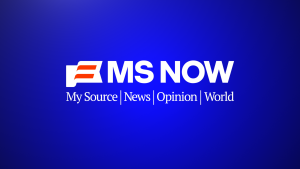
The Elements of the MSNBC or the MS NOW Logo
Font
MS Now, formerly the MSNBC network, employs a wide, clean, and geometric sans serif typeface to emphasise boldness and modernity.
Colour
The colour scheme used by MS Now encompasses patriotic red, white, and blue. Here, the colour red symbolises valour and hardiness, while white symbolises purity and innocence. Blue symbolises justice, vigilance, and perseverance.
The History of MSNBC
MSNBC was officially launched on July 15, 1996, and it represented an unprecedented collaboration between the technology and media industries. The joint venture emerged from the vision of an NBC executive, Tom Rogers, to combine traditional television news with emerging internet capabilities. Resultantly, the new entity partnered with Microsoft at the height of the dot-com boom. Microsoft’s substantial investment of $221 million for a 50 percent share of the cable channel demonstrated its serious commitment to entering the media landscape.
The partnership extended beyond mere financial backing, as Microsoft and NBC shared the cost of constructing a state-of-the-art $200 million newsroom in Secaucus, New Jersey, specifically designed for MSNBC.com operations. This facility represented a significant technological advancement for its time and was designed to facilitate the seamless integration of web and television content. The network’s name itself reflected this dual identity, for it combined “MSN” (Microsoft’s online service) with “NBC” to create a portmanteau that symbolised the merger of digital and broadcast media.
The launch came at a crucial moment in cable news history, as MSNBC took over the channel space previously occupied by NBC’s America’s Talking (AT) network. This transition presented both opportunities and challenges, as the new network needed to establish its identity and audience while competing against the already-established CNN and the newly launched Fox News Channel, which debuted the same year.
The early years of the network were marked by management instability and internal disagreements over strategic direction. These organisational challenges contributed to inconsistent programming quality and viewer confusion about the network’s identity. Despite these difficulties, MSNBC occasionally demonstrated its potential for breaking news coverage. For instance, it outdid CNN by eight minutes in reporting the crash of TWA Flight 800. This established a pattern of hypercompetitive breaking news coverage that continues to characterise cable news today.
However, the ambitious vision of seamlessly integrating internet and television content never fully materialised as originally conceived. The technological limitations of the late 1990s, combined with different consumption patterns for web and TV content, meant that the promised multimedia experience remained largely theoretical. Microsoft CEO Steve Ballmer later acknowledged in 2001 that he would not have started MSNBC had he foreseen the difficulty of attracting viewers.
The terrorist attacks of September 11, 2001, marked a key moment in the evolution of MSNBC. This tragic event temporarily transformed it into a crucial outlet for NBC’s extended breaking news coverage. With limited financial news to cover during the immediate aftermath, both CNBC and CNBC Europe frequently broadcast MSNBC programming for extended periods. This crisis coverage showcased the network’s capabilities and elevated the profile of correspondents like Ashleigh Banfield, who was present during the collapse of Building 7 while covering the World Trade Centre attacks.
The post-9/11 period also saw MSNBC adopt the slogan “America’s NewsChannel” and recruit opinionated hosts, including Alan Keyes, Phil Donahue, Pat Buchanan, and Tucker Carlson. This branding makeover represented an attempt to establish a more distinctly patriotic identity, though it was ultimately followed by declining ratings that forced further strategic reconsiderations.
The most significant corporate development during this period was Microsoft’s gradual divestment from the television operation. In December 2005, NBC Universal announced its acquisition of an additional 32 percent share of MSNBC from Microsoft. This gave NBC a controlling interest in television operations and allowed for greater integration with NBC News and other cable properties. Microsoft completely exited the television partnership in 2005, though it maintained involvement with MSNBC.com until 2012.
This transition fundamentally altered the network’s corporate structure and strategic direction. NBC later exercised its option to purchase Microsoft’s remaining 18 percent interest in MSNBC. The separation left the “MS” in MSNBC as a historical artefact with no current corporate meaning.
The arrival of Keith Olbermann in 2003 marked the beginning of MSNBC’s transformation from a traditional news network to a vehicle for political commentary. Olbermann’s “Countdown with Keith Olbermann” premiered on March 31, 2003. Initially, it followed a conventional news format with the host ranking the five biggest news stories of the day in reverse numerical order. The show’s early approach balanced serious political coverage with lighter segments, including the popular “Oddball” feature that highlighted bizarre news stories.
However, with time, Olbermann began incorporating more pointed political commentary. His “Special Comment” segments became a signature feature, which offered blistering critiques of conservative politicians and media figures. This evolution represented a significant departure from traditional network news objectivity. It established a template for opinion-driven programming that would define MSNBC’s future direction.
Olbermann’s approach proved successful with audiences seeking liberal alternatives to Fox News, but it also generated significant controversy and tension with NBC management. His combative style and open disdain for network protocols frequently put him at odds with executives. These created an atmosphere of constant conflict that would ultimately contribute to his departure in 2011.
In October 2010, MSNBC unveiled its “Lean Forward” marketing campaign. It was a $2 million initiative that President Phil Griffin described as an effort to position the channel as a progressive competitor to Fox News. This campaign represented the network’s full embrace of its liberal identity.
The “Lean Forward” slogan symbolised the network’s commitment to proactive engagement with political issues rather than passive reporting. This approach differentiated MSNBC from CNN’s attempts at centrism and positioned it as the liberal alternative to Fox News’s conservative programming.
The development of “Morning Joe” in 2007 provided MSNBC with a successful morning programme that combined political discussion with the conversational format popularised by traditional morning shows. Hosted by former Republican congressman Joe Scarborough and Mika Brzezinski, the programme offered a more centrist alternative to the network’s evening programming while maintaining MSNBC’s focus on political content.
The show’s success in attracting both liberal and moderate viewers demonstrated the potential for more ideologically diverse programming within MSNBC’s political framework. By 2017, “Morning Joe” became the first programme in the network’s history to average over 1 million daily viewers for an entire month. It became a significant competitor to Fox News’s “Fox & Friends”.
Microsoft’s final exit from MSNBC operations occurred in July 2012 when the company sold its stake in MSNBC.com to NBCUniversal. The website was subsequently rebranded as NBCNews.com to associate it more closely with NBC News as a whole. At the same time, MSNBC.com was relaunched as a website specifically for the cable channel. This separation resolved longstanding concerns about potential confusion between the two properties due to their diverging editorial approaches.
The transition reflected broader changes in digital media consumption and the growing importance of online platforms for news distribution. NBCUniversal News Group was created on July 19, 2012, under chairwoman Pat Fili-Krushel. It consolidated NBC News, CNBC, and MSNBC units under unified management. This organisational restructuring enabled greater coordination between the various NBC news properties while allowing each to maintain its distinct identity.
Under new leadership in the 2020s, MSNBC began gradually reducing its reliance on NBC News personalities and resources while expanding its opinion programming across different departments. This strategy reflected both the anticipated spin-off of NBCUniversal’s cable networks and the network’s desire to establish greater editorial independence.
MSNBC’s ratings during the Trump presidency and its aftermath demonstrated the network’s continued relevance in American political discourse. After Trump’s election victory in 2024, the network experienced significant audience fluctuations. Its viewership declined by 46 percent compared to the first ten months of 2024. However, Rachel Maddow’s return to five-night-per-week hosting for Trump’s first 100 days resulted in substantial ratings recovery. In fact, the network saw a 61 percent increase in weekday primetime viewership since Trump’s inauguration.
The most dramatic change in MSNBC’s history is currently underway as its parent company Comcast prepares to spin off NBCUniversal’s cable networks into a new publicly traded entity called Versant. This separation involves removing all NBC branding elements, including the iconic peacock logo that has been central to MSNBC’s visual identity since its inception.
The network has been officially rebranded as “MS NOW” on 18th August, 2025, with the new name standing for “My Source for News, Opinion and the World”. This transformation represents both continuity and change. It maintains the familiar “MS” initials while completely redefining their meaning for a new era of independent operations.
The transition to MS NOW coincides with MSNBC’s efforts to establish a completely independent newsgathering operation separate from NBC News. The network has been actively recruiting journalists from outlets including CNN, Bloomberg, and Politico to create its inaugural Washington, D.C., bureau. This investment in original reporting capabilities represents a significant strategic shift toward greater editorial independence and reduced reliance on NBC News resources.
MSNBC President Rebecca Kutler has emphasised that the rebrand represents operational change rather than philosophical transformation. However, the elimination of NBC branding and the establishment of independent newsgathering operations suggest more fundamental changes may be ahead as the network adapts to its new corporate structure.
Interesting Facts About MSNBC
- MSNBC was launched on July 15, 1996, as a joint venture between Microsoft (“MS”) and NBC (“NBC”).
- At its launch, MSNBC was unique in combining a cable news channel with a companion website (msnbc.com). It was designed to be a digital-first news platform before online news became mainstream.
- Although Microsoft co-founded the network, it sold its stakes in MSNBC gradually and fully exited the partnership by 2012.
- While MSNBC initially attempted to provide neutral news coverage, it gradually became known for its liberal and progressive commentary, particularly from the mid-2000s onwards.
- The channel saw a significant rise in viewership during the 2008 U.S. presidential election, especially with coverage favouring Democratic perspectives.
- MSNBC has been home to several well-known hosts, including Rachel Maddow, Chris Hayes, Lawrence O’Donnell, Andrea Mitchell, and formerly Keith Olbermann.
- Rachel Maddow’s prime-time show became a flagship programme for the network. It drew high ratings and recognition for in-depth political analysis.
- MSNBC broadcasts from 30 Rockefeller Plaza in New York City, which is a historic building often associated with NBC programming.
- While MSNBC is an American network, its content is broadcast worldwide through partnerships and digital streaming.
- Alongside CNN and Fox News, MSNBC is one of the “big three” cable news channels in the U.S.
- MSNBC relies heavily on the resources of NBC News. It often features NBC correspondents and uses their reporting to strengthen coverage.
- Beyond live news, MSNBC also airs documentaries and investigative specials on politics, history, and social issues.
Finally
The evolution of the MSNBC logo reflects both design trends and corporate changes, as well as the broader transformation of news media in the digital age. So, what began as an innovative internet-television hybrid has transformed into MS NOW. The network’s visual identity has consistently adapted to serve both functional broadcast needs and strategic brand positioning.